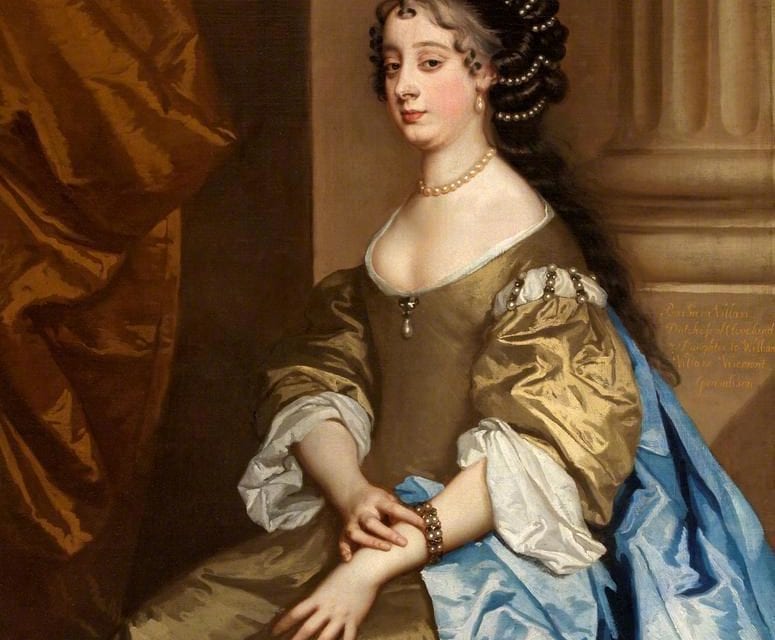

The Villiers family exploded onto the Royal scene in 1614 when George, later Duke of Buckingham, caught the roving eye of James I and it remained there for more than a hundred years. Never straying too far from the Royal bedchamber, this post about Lady Mary Bentinck begins a short series on those members of the family descended from Sir Edward and his wife Barbara St. John.
Anne Hyde, Duchess of York commissioned the Restoration court’s favourite artist, Peter Lely, to paint a series of portraits which became known as the Windsor Beauties. Thirty years later her daughter Queen Mary II would engage Godfrey Kneller to do the same. Kneller’s portraits were painted specifically for Hampton Court Palace where last summer they were central to the hugely successful exhibition The Wild, the Beautiful and the Damned.
Peter Lely painted several portraits of the notorious Barbara, Countess of Castlemaine, Charles II’s most feisty and interfering mistress and mother of five of his illegitimate children. In 1694 Kneller painted Barbara’s kinswoman Lady Mary Bentinck. First cousins once removed, the two women traced their ancestry back to Sir Edward Villiers and his wife Barbara St John who spent her childhood at Lydiard Park in Wiltshire.
The Villiers Royal connections were close as the family rose to prominence on the coat tails of George Villiers, favourite of King James I.
Mary’s grandfather Sir Edward Villiers fought on the Royalist side during the English Civil War and was wounded at the first Battle of Newbury in 1643. He was implicated in a plot to assist the escape of the Duke of York, and fled aboard where he continued to work for the Royalist cause as a member of the Sealed Knot, a secret organisation to bring about the Restoration of the monarchy, operational during the Commonwealth period.
His wife Lady Frances Howard meanwhile secured places at court for four of her daughters, Anne, Elizabeth, Barbara and Katherine who were appointed as Ladies of the Bedchamber to the young Princesses Mary and Anne. Anne, Elizabeth and Katherine Villiers accompanied Mary to The Hague following her marriage to Prince William of Orange and it was here that Anne married William’s close confidante Hans Willem Bentinck.
When William and Mary became joint monarchs following the Glorious Revolution young Lady Mary Bentinck came with them as one of the new Queen’s ladies in waiting. It was therefore fitting that Mary should number among Kneller’s Hampton Court Beauties.
In 1698 Mary married the equally beautiful Algernon Capell, 2nd Earl of Essex pictured here as a boy. Algernon inherited the title 2nd Earl of Essex aged just 13. His father Arthur Capel had been implicated in the Rye House Plot to assassinate Charles II and his Catholic brother James Duke of York and secure the succession of Protestant James, Duke of Monmouth, the eldest of Charles’s illegitimate sons.
Arrested at the family seat Cassiobury Park on July 9, Arthur was taken to the Tower of London where four days later he was discovered in his chamber with his throat cut. Although it was widely believed he had been murdered, the coroner’s verdict was suicide, his motive to prevent an attainder and to preserve his estate for his family.
Algernon joined Mary at Court where he held the office of Gentleman of the Bedchamber to William. He served as Colonel and Lieutenant General in the 4th Dragoons, was Constable of the Tower of London and Lord Lieutenant of Hertfordshire and in 1708 a Privy Councillor. He also entered into the spirit of the age and was described as ‘the lewdest young man in town,’ no mean feat considering the competition. He was a member of the Kit-Cat Club, a gentleman’s club patronised by the movers and shakers of the 18th century with a Whig allegiance. Famous for the members appreciation of beautiful women, Lady Mary had her very own Kit-Cat toast.
To Essex fill the Sprightly Wine
The healths immortal and Divine
Let purest Odours Scent the Air
And Wreaths of Roses bind her hair
On her Chaste lips these blushing lie
And those her gentle sighs supply
Algernon died in 1710 and in 1714 Mary married the Rt Hon Sir Conyers Darcy. Mary died in 1726 aged 47 years old. She led a full and busy life and her memory lives on – in the words of the Kit-Cat toast and in the evocative Kneller portrait.